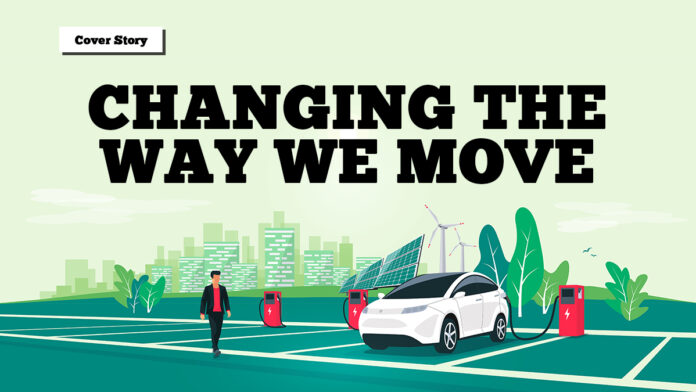Urban mobility is changing around the world. Countries have started electrifying their public transport systems, and powering them with sustainable energy. Many European nations are shifting their definition of city roads, now focusing more on people instead of cars.
Here is how urban mobility is changing the way we move:
Electrification and mini-mobility
Last year, we talked about EVs and how they are a more sustainable mobility solution. Beyond sustainability, EVs can also be a good personal mobility solution for highly urbanized areas, such the cute Mini EVs that have started entering the Philippine market.
Mini EVs like the Jetour Ice Cream (Chery Ice in other markets) and Wuling Hongguang Mini EVs have taken over the Chinese motoring industry. These cars, fashioned after the Japanese Kei-cars, serve as a personal transport solution in Chinese cities. They’re highly sought after because of their cheap price (around USD5,000 or roughly around PHP300,000), their small and nimble frame, and finally their cheap operational cost as an EV.
The sole purpose of these Mini-EVs, and even the Kei cars that preceded them, is to transport a person from point A to point B within the city. They were created with a limited range (for EVs) and speed. They’re economical not just because they are electric-powered but also because of they consume little energy due to their compact size.
Adopting Mini-EVs will not change the primary problem within our transport system, the deadly traffic. They are, after all, still cars; but they offer a more economical way of traveling and consume less road space – now a luxury in rush hour Manila.
Beyond the current Mini-EVs in the market, other mini-mobility solutions are being considered. There are smaller EVs that can carry one or, at most, two persons — similar to a motorcycle but with four wheels and enclosed. They’re made for people who are afraid of riding e-bikes or electric scooters.
These small EVs are the perfect solution for metro traffic because they’re smaller, therefore consuming a lot less space; they’re safer than a motorcycle; and they offer a more sustainable mode of transportation.
The challenges in electrification
The electrification of mobility also comes with am infrastructure challenge. Many people are skeptical about EVs mainly because of range anxiety from the lack of publicly available charging spots. Sure, home charging is a solution, but for those living in a condominium or apartment, home charging may not be a feasible.
So what’s the deal with the lack of EV infrastructure? For me, it’s an economic dilemma arising from lack of demand. Currently, the number of EVs in the market is still relatively low (compared to other nations). There is also a higher initial cost for EVs compared to conventional internal combustion engines. But with the new government measures promoting EVs like the EVIDA law and the president’s February Executive Order removing tariffs on EVs, we can expect more and more EVs to enter the market.

How other countries made the shift to EVs
If there is a model country for the uptake of EVs, it’s Norway. The Scandinavian country has trumped the rest of the world when it comes to EV adoption — 80% of total car sales in 2022 were EVs. It managed to do this by making EVs a better option than regular ICEs.
Norway offered massive tax breaks on EVs. Additionally, it offered massive perks from the years 2000 – 2017. EVs were exempted from paying tolls, ferries, and even parking. Additionally, the country invested heavily in charging infrastructure, going as far as requiring apartments and other multi-story housing to have their electric wiring ready in case a tenant wants to install an EV wall charger.
In Asia, China remains the largest EV adapter with 22% of its total car sales in 2022 being EVs. While that may look like a small percentage, you have to remember that China is the world’s largest auto market with 26.86 million vehicles sold in the country just in 2022. The EV sales number is expected to grow even larger this year with more car manufacturers offering higher value cars, investing more in EV infrastructure, all supported by a massive government subsidy for both car manufacturers and buyers.
In Southeast Asia, Thailand is becoming the leader in EV adoption. While it recorded just 1% of total car registrations as EVs, that number grew to 6% in just January – April of this year. Leading the charge in EV sales in Thailand are Chinese EV giants BYD, SAIC Motors (MG), and Great Wall Motor. The country is also offering its existing car manufacturing expertise to these car makers, hoping to become Southeast Asia’s EV manufacturing hub.
How the Philippines can shift to EVs
In Deloitte survey on preference of EVs in Southeast Asia, it was found that Thailand ranked the first in wanting their next car to be an EV. The Philippines had the lowest take up with 72% of Filipinos still wanting an ICE in their next vehicle. The preference is due to the lack of EV infrastructure in the country.
The 72% may look high, but that is 10% lower than the previous year. The study found that 55% of respondents were mainly concerned about the lack of EV infrastructure. Other apprehensions were the time it takes to charge (51%), and safety concerns about battery technology (45%). Other concerns were driving range, and lack of alternative power sources at home (43%).
The results of the survey are very clear, Filipinos want the EV infrastructure to be ready before gaining confidence to shift to EVs. As more EVs enter our market, we can hope that the infrastructure can keep up — so we can change the way we move.
Words by Gabriel Pe
Also published in GADGETS MAGAZINE September 2023 Issue
